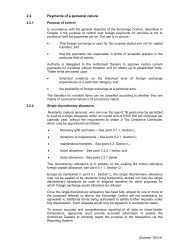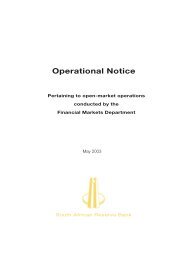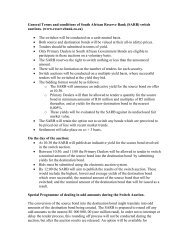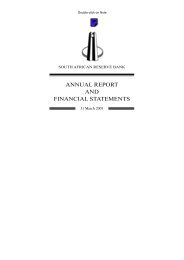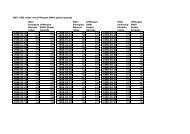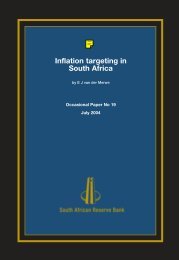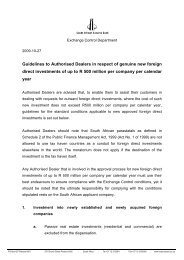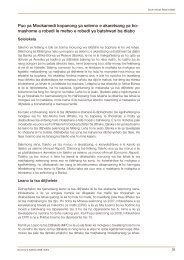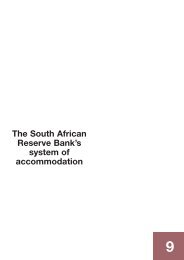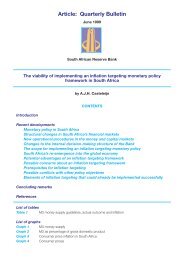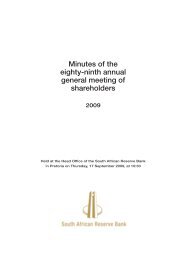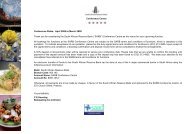Signaling currency crises in South Africa - South African Reserve Bank
Signaling currency crises in South Africa - South African Reserve Bank
Signaling currency crises in South Africa - South African Reserve Bank
Create successful ePaper yourself
Turn your PDF publications into a flip-book with our unique Google optimized e-Paper software.
SARB Conference 2006As expected the so-detected <strong>currency</strong> crisis months are concentrated <strong>in</strong> the first part of thesample. The picture shows that there have been crisis-significant <strong>in</strong>terventions <strong>in</strong> March, Julyand August 1994, which were not followed by significant depreciations and have therefore notbeen detected by the broader EMP approaches. However, these months are not called a crisisif the threshold is <strong>in</strong>creased to 2,5 times sigma (as can be seen from the table <strong>in</strong> the appendix).In 1996 there have been <strong>in</strong>terventions dur<strong>in</strong>g April (a month already detected as a crisis month)and October, a month so far seen as a po<strong>in</strong>t after the 1996 crisis. The <strong>in</strong>dications <strong>in</strong> 1998 areaga<strong>in</strong> <strong>in</strong> l<strong>in</strong>e with what has already been detected. After June 1998 no significant <strong>in</strong>terventioncould be observed.Us<strong>in</strong>g the 25 percent annual depreciation criterion as an additional condition for an event to becalled a <strong>currency</strong> crisis, the respective months are marked by an exclamation mark <strong>in</strong> theannexure. Of the so far detected potential crisis months, October 1996, July and August 1998,as well as December 2001 show depreciations of the exchange rate of above 25 percentcompared to the pre-year month.As a f<strong>in</strong>al measure for determ<strong>in</strong><strong>in</strong>g <strong>currency</strong> <strong>crises</strong> the simple method of requir<strong>in</strong>g a certa<strong>in</strong>current depreciation of the exchange rate is used. Brüggemann and L<strong>in</strong>ne (2002) use thecriterion of 20 percent depreciation with<strong>in</strong> ten trad<strong>in</strong>g days. Accord<strong>in</strong>g to this criterion only oneday dur<strong>in</strong>g the period of observation would be called a crisis: 20 December 2001, 21,30percent. 13To sum up, the results drawn from the different <strong>currency</strong> crisis identification frameworksdepicted <strong>in</strong> the table <strong>in</strong> the appendix show that there is just one crisis month, <strong>in</strong>dicated as suchby all versions of the EMP, and that is April 1996. This month, however, is not detected as acrisis month with use of all the thresholds. April 1996 is surrounded by two months that showsome <strong>in</strong>dications for <strong>crises</strong>. Also, <strong>in</strong> October there have been significant <strong>in</strong>terventions due toongo<strong>in</strong>g depreciation. Other prom<strong>in</strong>ent months are May and June 1998 (not detected by theEMP <strong>in</strong>clud<strong>in</strong>g exchange rates only) and July 1998 (not detected by the EMP <strong>in</strong>clud<strong>in</strong>g reservesonly) as well as December 2001 (obviously not detectable by the EMP <strong>in</strong>clud<strong>in</strong>g reserves only).The 1998 event is centered on June and July but surrounded by two months that show some<strong>in</strong>dication of <strong>currency</strong> <strong>crises</strong>. In 2001 the episode focuses very much on December with some<strong>in</strong>dications <strong>in</strong> October. The three events of April 1996, June/July 1998 and December 2001 can,with the back<strong>in</strong>g of the above analysis, be called <strong>currency</strong> <strong>crises</strong>.It is somewhat more questionable whether the 1994, the 2000, 2004, and 2005 episodes can becalled <strong>crises</strong>. The 1994 event shows some depreciation, which is low compared to the 1996,1998, and 2001 events. Interest rates had been ris<strong>in</strong>g as well, but the <strong>in</strong>creases of up to 1.1percentage po<strong>in</strong>ts have been relatively low. Only the reserves measure shows a severereaction <strong>in</strong> terms of the <strong>Reserve</strong> <strong>Bank</strong> with changes <strong>in</strong> reserves last observed e.g. <strong>in</strong> August1998. The impression from these figures is that the reaction of the <strong>Reserve</strong> <strong>Bank</strong> has beensuccessful <strong>in</strong> order to prevent a more serious depreciation and therefore a <strong>currency</strong> crisis. Thesuccessfully held elections <strong>in</strong> 1994 may have added to the stop of the depreciation episode.The episodes of 2000, 2004, and 2005 are more difficult to evaluate. The ma<strong>in</strong> concern is thepolicy switch, which can clearly be seen on the reserves chart <strong>in</strong> Figure 1. After the 1998 crisisthere have been no <strong>in</strong>terventions by the SARB that came close to the previously seen figures.As stated above, the SARB opted aga<strong>in</strong>st further <strong>in</strong>tervention <strong>in</strong> <strong>currency</strong> markets. Figure 7shows an EMP <strong>in</strong>dex <strong>in</strong>clud<strong>in</strong>g exchange rates, <strong>in</strong>terest rates and reserves calculated us<strong>in</strong>gdata from 1998/12 onwards.13 The daily exchange rate data are provided by Datastream.Knedlik 205



